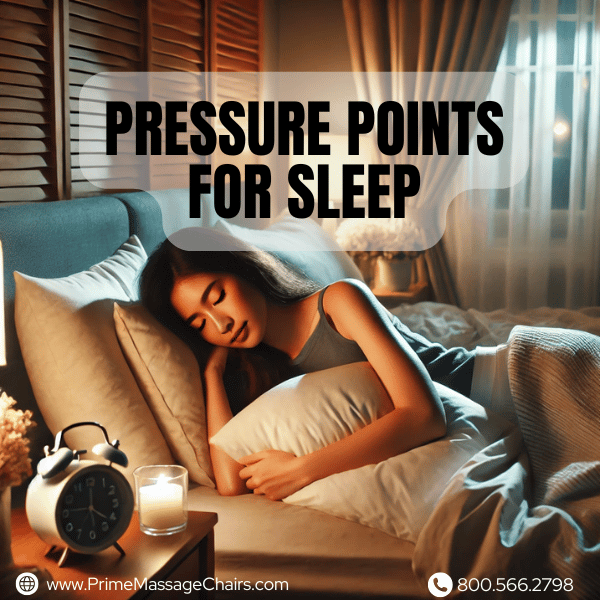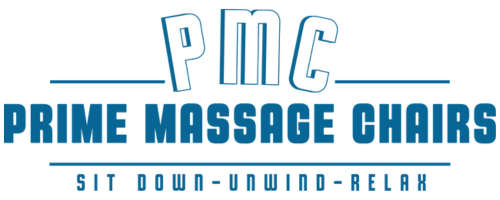
Pressure Points for Sleep
Are you familiar with pressure points for sleep? Many people have trouble sleeping at night. Acupressure might help with this problem.
This post will show you how pressure points for sleep can make bedtime easier.
Let's get started!
What Are Pressure Points For Sleep?
Moving on from the basics, let's talk about pressure points for sleep.
These are special spots on your body that can influence how well you sleep. They are sensitive areas linked to different health aspects.

Using pressure on these points is a method called acupressure. This approach is similar to acupuncture but doesn’t use needles.
A study in 2010 suggested that older adults who received acupressure experienced better sleep quality.
So, pressing these points may help if you're struggling with insomnia or just want to improve your sleep quality.
Acupressure can help with insomnia by targeting specific pressure points. Some key spots include Spirit Gate, Three Yin Intersection, and Bubbling Spring among others.
Pressing these can help ease your mind and lead to a peaceful night’s sleep.
This method uses gentle yet firm touch on certain parts of your body like the hand or foot to promote relaxation and improve sleep patterns.
Can Pressure Points Help With Sleep Issues?
Yes, pressure points may help with sleep issues.
Acupressure, a method that applies firm pressure to certain spots on your body, has shown positive results.

For example, a small study found that 60% of participants slept better after 10 days of treatment.This suggests that it may improve sleep quality.
This method can work well for many, including those facing health challenges like cancer.
Many patients in these situations struggle with sleep, and some research indicates acupressure might improve their sleep quality.
Applying gentle or firm pressure on specific points may help you fall asleep and stay asleep longer.
It can be a helpful tool for anyone looking to find peace and rest at night without using medication.
Top Pressure Points To Improve Sleep
We have some great spots on your body that can make sleep better. These spots, when pressed the right way, can help you fall asleep faster.

They are like magic buttons for rest. The Spirit Gate, Inner Gate, Bubbling Spring, Wind Mansion, and Third Eye are all places to try out.
Pressing these can lead to a night of more peaceful sleep. Want to know how? Keep reading!
Spirit Gate Point (HT7)
Spirit Gate, or HT7, is a pressure point found on the underside of your wrist. It's known for its power to help you relax and fall asleep.
Some studies suggest that pressing HT7 may improve sleep.
For example, a study in 2010 saw good results using this spot to ease insomnia.
People who had acupressure on the Spirit Gate point felt their sleep got better during the treatment, and even two weeks after stopping, they still slept well.
This point also appears to help Alzheimer’s patients by improving sleep duration and helping them fall asleep faster.
Applying pressure here might be what you need for restful nights. Use acupressure on Spirit Gate to promote sleep and improve how long you stay asleep each night.
Inner Gate Point (P6)
The Inner Gate (P6) is a spot on your inner forearm. Find it by measuring three finger widths down from your wrist.
Pressing this point may help with sleep. It can also help with nausea and other symptoms that might disturb sleep.
A study in 2010 showed that using the Inner Gate point helped improve sleep. So, applying pressure here could be helpful if you're trying to get better sleep.
This method is part of acupressure therapy, an easy way to help yourself rest more without needing medicine.
Bubbling Spring Point (KD1)
Bubbling Spring, or KD1, is a point on the sole of your foot, right beneath the ball. Pressing this spot can help relax your body and calm your nerves.
This makes it helpful for people who need to relax before bed.
A study in 2019 suggested that using pressure on points like KD1 helped reduce fatigue in people with migraine headaches.
Applying pressure to Bubbling Spring may promote relaxation and improve sleep.
Wind Mansion Point (GV16)
The Wind Mansion, or GV16, is a spot at the base of your skull. Pressing this point may improve sleep quality.
It can also help with headaches and tension. A study in 2017 suggested that applying pressure to this point may offer relief.
This pressure point is great if you're looking to relax before bed. After applying pressure here, moving on to the Third Eye point could help even more with falling asleep.
Third Eye Point (Yintang)
Yintang sits between your eyebrows. This spot is often used to address sleep issues like insomnia and stress.
A study in 2010 suggested that older adults experienced improved sleep after applying pressure here.
It helps calm the mind, making it easier to fall into a deep sleep.
Pressing Yintang can help reduce anxiety and make it easier to fall asleep. Just apply gentle pressure to this point for relief.
It can help create a smoother transition into restful sleep.
How To Apply Pressure Points For Better Sleep
Applying pressure points may help you sleep better. Here is how you do it at home:
-
Find a quiet, comfortable place where you won't be disturbed. This helps your body relax and makes acupressure more effective.
-
Sit or lie down in a position that lets you easily reach the pressure point you want to stimulate.
-
Use your thumb or finger to apply gentle but firm pressure to the sleep-related acupressure point, like the Spirit Gate (HT7) on your wrist.
-
Hold this pressure for about 30 seconds, then slowly release it. This time lets your body respond to the stimulation.
-
Repeat applying pressure on both sides of your body to keep the balance and enhance the effect.
-
For better results, move through all recommended points: KD1, SP6, PC6, HT7, An Mian, and Yin Tang. Doing them in order can help create a routine.
-
Experts say doing this for 15 minutes before bed is best for improving sleep quality.
-
You can press these points every night or as often as needed to help with sleep issues.
When To Consult A Doctor For Sleep Issues
A doctor can check for sleep disorders or other health issues.
You should also talk to a healthcare professional if stress or anxiety mess with your rest.

If medications for sleep don't work for you, or they make you feel bad, that's another sign to get help from a doctor.
They can suggest different ways to improve your night's rest without those side effects.
FAQs
What Are The Pressure Points For Sleep?
Pressure points for sleep are specific spots on your body, often used in acupressure and acupuncture, that when stimulated may help you fall asleep faster and enjoy a more restorative sleep.
How Does Applying Pressure To These Points Work?
Applying gentle or deep pressure to each point stimulates energy pathways in your body, creating relaxation conducive to a smooth transition into sleep.
It's all about achieving balance in the body's energy flow.
Can Acupressure Really Improve My Quality Of Sleep?
Yes! Clinical trials have shown promising results with improved sleep quality in middle-aged individuals and those staying at long-term care facilities with insomnia.
Acupressure may help relieve insomnia and other common sleep disturbances.
Do I Need Professional Assistance To Stimulate These Pressure Points?
While having acupressure done by a professional is beneficial, self-administered acupressure is also effective.
You apply firm or light pressure with your thumb or finger in a circular motion to stimulate the chosen pressure point.
Are There Any Particular Groups Who Benefit From This Technique?
Acupressure has been found helpful for people suffering from chronic conditions like hypertension and mental disorders which often disrupt normal sleeping patterns, according to some studies.
Where Exactly Are These Five Key Pressure Points Located?
The exact locations vary but typically include areas on the neck, below the wrist bone near your little finger, between your eyebrows (third eye), just below the inner ankle bone, and underfoot towards the heel edge.
Conclusion
Finding better pressure points for sleep might be closer than you think.
With pressure points, a method from alternative medicine, you tap into your body's power to calm down and get ready for rest.
This approach may make the night easier for anyone looking to improve their sleep, especially if other methods haven't worked well.
Make these pressure points part of your bedtime routine. Soon, you may notice that slipping into dreamland has become a bit easier.
Disclaimer:
We do not provide medical advice. The content of this article, including text, graphics, and other material, is for informational purposes only. It is not intended to be a substitute for professional medical advice, diagnosis, or treatment. Always seek the advice of your physician or other qualified health provider with any questions you may have regarding a health condition. Never disregard professional medical advice or delay in seeking it because of something you have read in this article or on our website.
